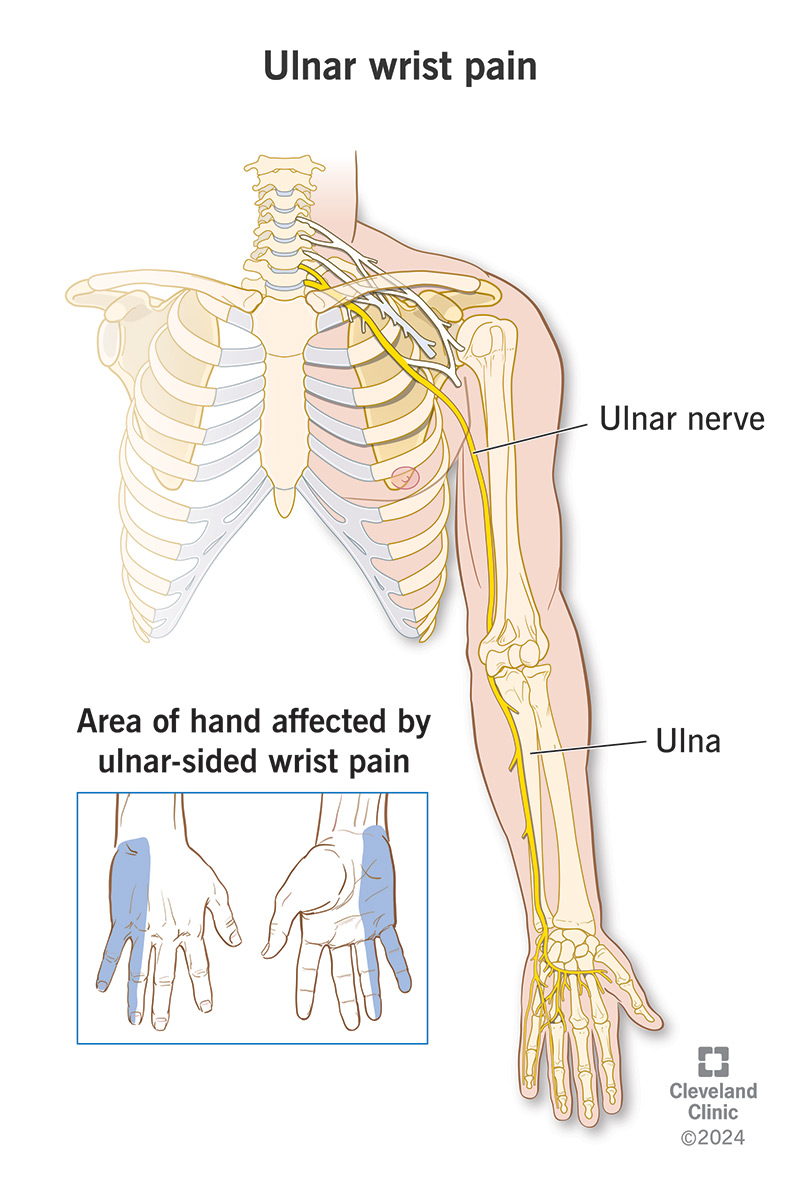Ulnar wrist pain is a common symptom caused by a lot of injuries and health conditions. You can typically manage it with rest and at-home treatments. Visit a healthcare provider if ulnar wrist pain lasts more than a few days, or if you’ve experienced a fall or other injury.
Advertisement
Cleveland Clinic is a non-profit academic medical center. Advertising on our site helps support our mission. We do not endorse non-Cleveland Clinic products or services. Policy

Ulnar wrist pain is pain or discomfort in your wrist on the same side as your ulna (one of the bones in your forearm). It’s a specific type of wrist pain.
Advertisement
Cleveland Clinic is a non-profit academic medical center. Advertising on our site helps support our mission. We do not endorse non-Cleveland Clinic products or services. Policy
The ulnar side of your wrist is the side your pinkie finger is on. Some people call it outer wrist pain or pain on the outside of their wrist. Healthcare providers call it the ulnar side of your wrist because it’s a quick way to know exactly where the pain is, even if you’re turning your wrist over (the outside can change depending on how you position your wrist and hand).
Your wrist is a complex joint made of:
Lots of injuries and health conditions can cause ulnar wrist pain. You can usually manage it at home with rest and over-the-counter pain relievers. But don’t ignore severe, sudden pain, especially if you know you experienced a wrist injury.
Visit a healthcare provider if you’re experiencing ulnar wrist pain that doesn’t go away in a few days, the pain is getting noticeably worse or if you can’t move or use your wrist.
Injuries and health conditions that affect the bones and tissue in your wrist are the most common causes of ulnar wrist pain.
Any physical damage to your wrist can cause pain. Some of the most common injuries that cause ulnar wrist pain include:
Advertisement
Many health conditions can cause ulnar wrist pain. They usually cause pain that gets worse over time (instead of happening all at once like a sprain or fracture). Some of the most common conditions that cause ulnar wrist pain include:
A healthcare provider will suggest treatments to help manage pain and any other symptoms you’re experiencing. Which treatments you’ll need depends on what’s causing the ulnar wrist pain.
Some of the most common treatments for ulnar wrist pain include:
Follow these general safety tips to reduce your risk of a wrist injury:
Using a computer or keyboard every day is a common cause of ulnar wrist pain. You can reduce stress on your wrists by:
Visit a healthcare provider if you’re experiencing any type of wrist pain that doesn’t get better in a few days, or if the pain gets worse over time. See a provider if you have any of the following symptoms:
Advertisement
Ulnar wrist pain is usually temporary and gets better when you take a break from the activity that caused it. How long that will take depends on why your wrist hurts, if you experienced an injury or have a health condition.
Injuries may cause pain until they heal. Sprains usually last a few weeks, but it might take a few months for a broken wrist to heal completely.
Health conditions that cause ulnar wrist pain can be temporary issues or chronic (long-term) conditions. Ask your healthcare provider what to expect.
Everyone has the occasional ache or pain in their wrist. Everything from a long day at work typing on a keyboard or an afternoon pulling weeds in the yard can cause temporary ulnar wrist pain. Even sleeping in an unusual position can hurt your wrist when you’re not even conscious to know it happened.
Most cases of ulnar wrist pain are temporary annoyances, but don’t ignore pain that lasts long enough to affect your daily routine — especially if you notice it going away and coming back over and over. A healthcare provider can help you understand what’s causing the pain in your wrist and what you can do to get back to feeling like yourself.
Advertisement
Cleveland Clinic’s specialized orthopaedic team are experts in wrist replacement. We can help you enjoy activities without wrist pain.

Last reviewed on 10/01/2024.
Learn more about the Health Library and our editorial process.